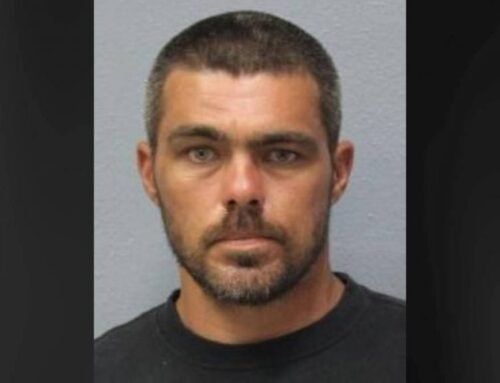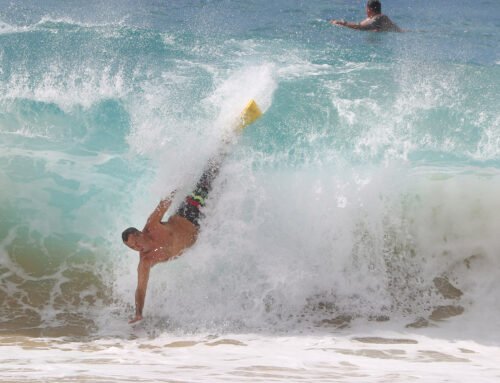At Hanakaoʻo Park in Lahaina, 15 students crowded around a table, plunging their hands into piles of black kukui, still sandy and wet from the ocean. The students identified the smoothest, shiniest nuts, then proudly showed off their finds to Kauna’oa Garcia.
Garcia, an elementary school teacher in the state’s Hawaiian language immersion program, plans to drill holes in the kukui and help students make their own lei.
Less than five miles away, Garcia’s fellow teachers welcomed students into their classrooms at Princess Nahienaena Elementary, which reopened for instruction last week.
But as concerns around the safety of Lahaina campuses linger, Garcia called out sick and instead offered informal lessons at the beach park for students in the Department of Education’s Hawaiian Language Immersion Program, or Ka Papahana Kaiapuni Hawaii.
“We were respectful to what’s happening, but we still need to move on,” Garcia said. “And I think this is part of them moving on, being together, but not at the campuses really close to the burn zone.”


The informal lessons, which Garcia taught in partnership with two other Kaiapuni teachers, were for Lahaina students in elementary and middle school. Of the 41 students the teachers served before fall break, 36 attended classes at the park last week.
In all, 53 Kaiapuni students returned to Hawaiian immersion classes in Lahaina last week. Excluding charter schools, there are 22 immersion programs in the state, but many, like those in Lahaina, are hosted on English-speaking campuses, according to the DOE’s website.
Over 160 Lahaina students were enrolled in the immersion program before the start of the year.
Hopes For A Separate Campus
Even with high student turnout at the beach park, it wasn’t the start to the quarter that Garcia imagined. Following the destructive Aug. 8 wildfire, families in Lahaina’s Kaiapuni program hoped to build a temporary campus in Napili. The program would remain under the DOE but would have a campus solely dedicated to serving immersion students in all grades, making it the first K-12 Kaiapuni campus on Maui.
Instead, the families were encouraged to send their children back to the Lahaina campuses, Princess Nahienaena Elementary, Lahaina Intermediate and Lahainaluna High, which reopened last week despite concerns about potential toxins and pollution from the nearby burn zone.
Deputy DOE superintendent Tammi Oyadomari-Chun said families can also enroll in the immersion program’s state distance learning program or attend other Maui schools offering Kaiapuni classes.
But Miriam Keo, a parent of two Kaiapuni students at Lahaina Intermediate, feels like she’s out of options. She worries about the environmental safety of Lahaina Intermediate’s campus, and she doesn’t feel comfortable sending her children across the island to attend a different Kaiapuni program. She added that she is reluctant to enroll her children in distance learning, citing their struggles with the online format during the Covid-19 pandemic.
“I just don’t feel like really any of those actions are doable for us,” Keo said.
The DOE has reiterated that extensive testing of schools’ water, soil and air quality indicated that students can safely return to classes. The department also created a new emergency access route running from the Lahainaluna fire lane to the Lahaina Bypass in a bid to address evacuation concerns.


But, a day before Lahainaluna High’s reopening, the DOE and Department of Health announced that preliminary ash testing from the Kula fires showed high levels of toxins that may also be present in the Lahaina burn zone.
In a Board of Education meeting last week, Chun said enrollment at the three Lahaina schools has dropped by approximately 900 students, and a significant number of those still enrolled did not attend the first day of classes. That included many students enrolled in the Hawaiian immersion program.
‘It Just Felt Like Home’
Amid initial uncertainty about whether the Lahaina schools would reopen after the fire, families and teachers saw the opportunity to rebuild the Kaiapuni program stronger than ever, said Kanoelani Steward, a Kaiapuni teacher at Lahaina Intermediate.
Support for creating a temporary campus exclusively serving Kaiapuni children across all grades intensified in September. As the Kaiapuni program offered daily field trips for the students, teachers saw how bringing together children of all ages could promote healing and responsibility, said Kala Tanaka, a Kaiapuni teacher at Lahaina Intermediate.
“It just felt like home. It felt natural,” Tanaka said. “When you look around, everyone is just so engaged and everybody’s helping to take care of each other.”
Building a temporary campus north of Lahaina would not only address families’ concerns around health and safety but would also provide a more immersive learning experience for students, Tanaka added. While Kaiapuni students receive instruction and converse in Hawaiian during class time, they are surrounded by English speakers at Lahaina Intermediate, Tanaka said.
“When you’re a school within a school, especially when the majority of the school is English (speaking), it’s all around you and you’re in this kind of little bubble,” Tanaka said.


Kalikolehua Storer, a parent of a Kaiapuni student at Princess Nahienaena Elementary, said she envisioned a temporary site that could serve approximately 200 Kaiapuni students. While many families wanted to eventually return to Lahaina to build a permanent K-12 Kaiapuni campus, they hoped to remain at a temporary site until the cleanup of the town finishes, she added.
“It was never our idea to stay north forever,” Storer said. “It was only as long as the toxic ash is present.”
Initially, Storer added, community partners were quick to respond to Kaiapuni’s needs. For example, she said, Maui Land & Pineapple Co. offered the Kaiapuni program 5.6 acres to use as a campus for five to 10 years, although the land would need to first be developed to clear the way for classrooms and facilities.
But the details around the offer remain unclear, with Maui Land & Pineapple claiming that it offered the 5.6 acres to a variety of nonprofits “at a nominal rate” that could help local groups access the land as needed.
Makalapua Kanuha, whose four grandchildren are in the Kaiapuni program in Lahaina, estimated that it would take approximately $5 million to construct the temporary campus. Local organizations offered financial support, she said, but many wanted reassurance that the project could come to fruition with the DOE’s support.
Chun said the department never received a formal proposal to build the temporary site in Napili.
At a meeting with Kaiapuni teachers in early October, Chun said she believed the temporary campus was still in its conceptual stages. She added that the department expected Kaiapuni teachers and families to return to the Lahaina campuses that had been cleared for reopening and encouraged the community to focus on potentially creating a permanent K-12 site in Lahaina.
But the meeting came as a blow to many families, who had placed their hopes in the opening of a temporary campus after fall break.
Next Steps
Three days after learning that there would be no temporary campus after fall break, Rena Pali was at a loss. Three of her children were enrolled at the Kaiapuni programs at all three schools, but Pali felt it was irresponsible to send them back to campuses where she feared the air quality could unexpectedly change.
“We’re backed up against a wall. We feel obligated to send them back,” Pali said. “We feel like we have no other choice.”


Charmane Yamada said her children in the Kaiapuni program remain enrolled at the three Lahaina schools, but only her sophomore at Lahainaluna High has returned to campus so far. She said she hopes the DOE will recognize families’ reluctance to send their children back to the Lahaina schools and will find a safer alternative for all students, including those not enrolled in the Kaiapuni program.
Chun said the DOE has not been in communication with Kaiapuni families about the temporary campus since fall break.
Finding or creating facilities accommodating all the Kaiapuni students is not out of the question, Chun added, but these classes would likely take place on Lahainaluna High’s campus.
Mikey Burke, whose four children attend the Kaiapuni program at Princess Nahienaena Elementary and Lahaina Intermediate, said she plans to keep fighting for a Kaiapuni campus where she feels safe sending her children.
“We have one chance to get this right,” Burke said.
Civil Beat’s education reporting is supported by a grant from Chamberlin Family Philanthropy.
Civil Beat’s coverage of Maui County is supported in part by grants from the Nuestro Futuro Foundation.







Leave A Comment